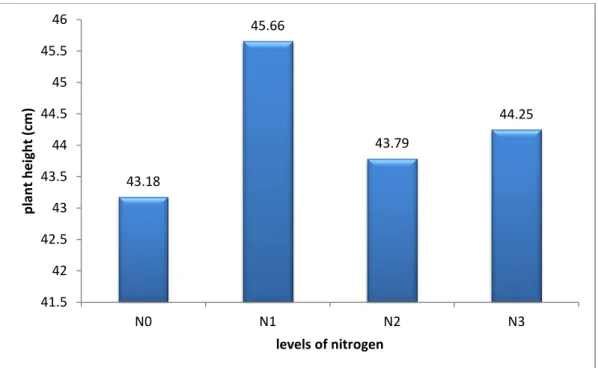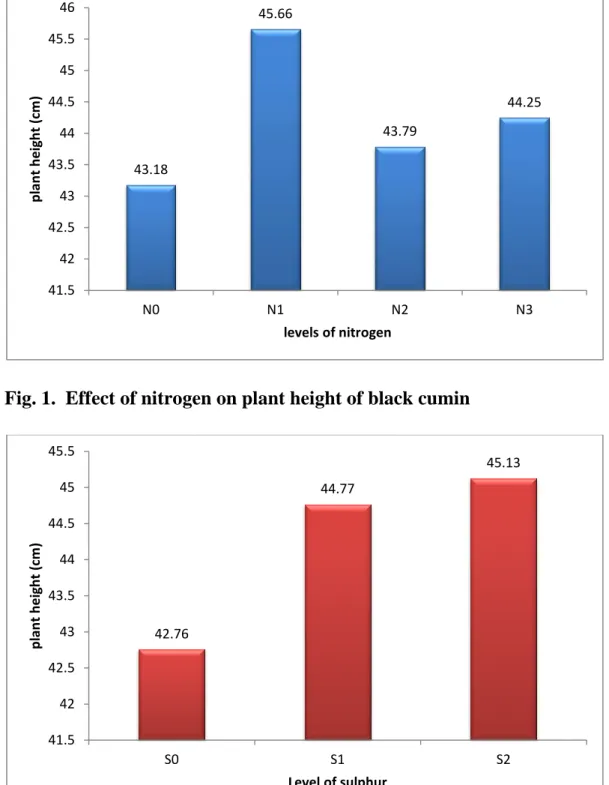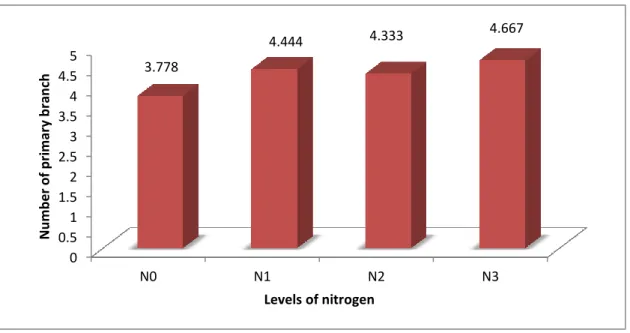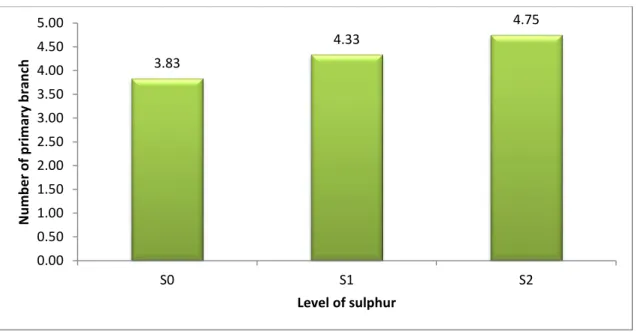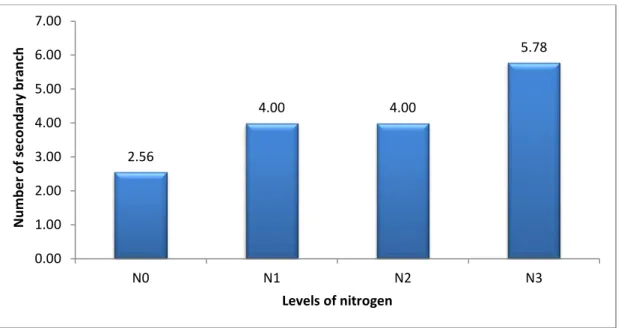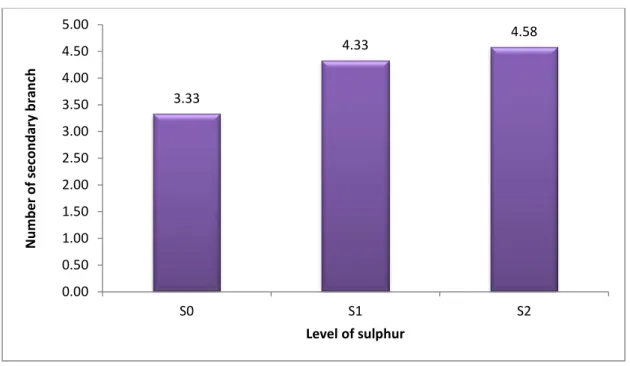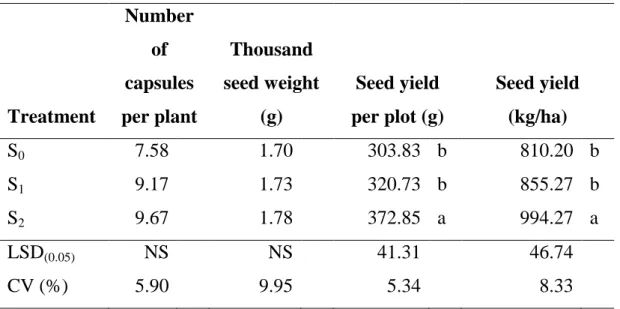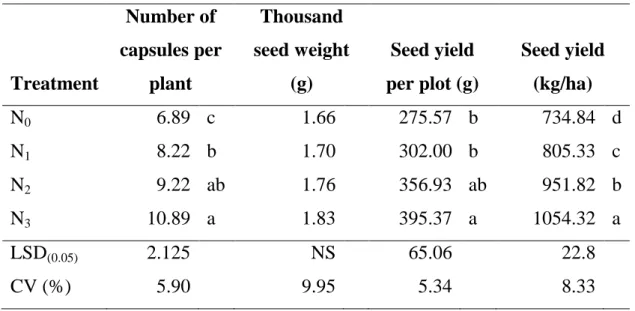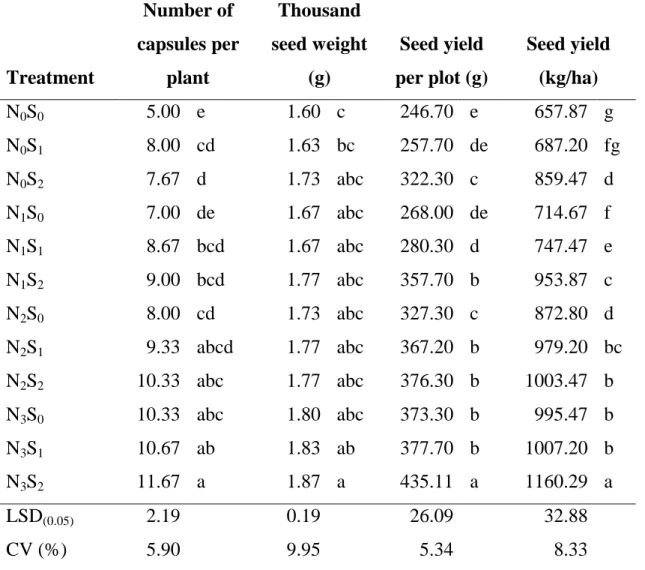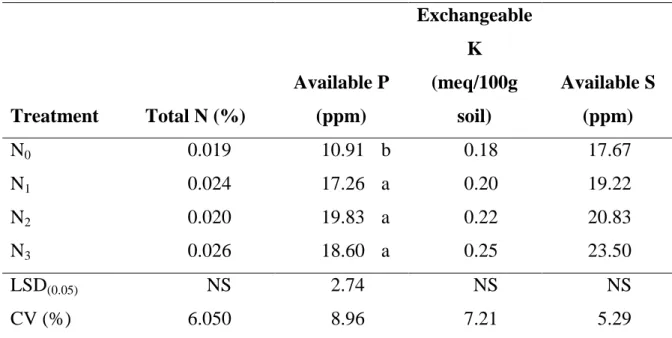EFFECT OF NITROGEN AND SULPHUR ON THE GROWTH AND YIELD OF BLACK CUMIN
MINHAZ AKTAR
DEPARTMENT OF SOIL SCIENCE
SHER-E-BANGLA AGRICULTURAL UNIVERSITY DHAKA-1207
JUNE, 2020
EFFECT OF NITROGEN AND SULPHUR ON THE GROWTH AND YIELD OF BLACK CUMIN
BY
MINHAZ AKTAR REGISTRATION NO: 13-05262
A Thesis
Submitted to the Faculty of Agriculture, Dept. of Soil Science Sher-e-Bangla Agricultural University, Dhaka,
in partial fulfillment of the requirements for the degree of
MASTER OF SCIENCE IN
SOIL SCIENCE
SEMESTER: JANUARY- JUNE, 2020
Approved by:
(Prof. Dr. Alok Kumar Paul) Supervisor
Department of Soil Science Sher-e-Bangla Agricultural University
(Prof. Dr. Md. Asaduzzaman Khan) Co-supervisor
Department of Soil Science Sher-e-Bangla Agricultural University
______________________________
(Prof. Dr. Alok Kumar Paul) Chairman
Department of Soil Science Sher-e-Bangla Agricultural University
CERTIFICATE
This is to certify that the thesis entitled, “
EFFECT OF NITROGEN AND SULPHUR ON THE GROWTH AND YIELD OF BLACK CUMIN
” submitted to the Faculty of Agriculture, Sher-e-Bangla Agricultural University, Dhaka, in partial fulfillment of the requirements for the degree of MASTER OF SCIENCE in SOIL SCIENCE, embodies the result of a piece of bona fide research work carried out by MINHAZ AKTAR Registration No.13-05262
under my supervision and guidance. No part of the thesis has been submitted for any other degree or diploma.I further certify that such help or source of information, as has been availed of during the course of this investigation has duly been acknowledged.
Dated:
Place: Dhaka, Bangladesh (Prof. Dr. Alok Kumar Paul) Supervisor
Department of Soil Science Sher-e-Bangla Agricultural University
D EDICATED TO
M Y B eloved P ARENTS
i
ACKNOWLEDGEMENT
All praises are due to the Almighty ''Allah'' Who kindly enabled the author to complete the research work and the thesis leading to Master of Science in Soil Science, Sher-e-Bangla Agricultural University, Dhaka, Bangladesh.
I would like to express my heartfelt respect, deepest sense of gratitude, profound appreciation and ever indebtedness to my supervisor, Professor Dr. Alok Kumar Paul, Department of Soil Science, Sher-e-Bangla Agricultural University, Dhaka for his sincere guidance, scholastic supervision, constructive criticism, extending generous help and constant inspiration throughout the course and in preparation of the manuscript of thesis.
I express my sincere respect to my Co-supervisor, Prof. Dr. Md. Asaduzzaman Khan, Department of Soil Science, Sher-e-Bangla Agricultural University, (SAU), Dhaka for his utmost co-operation, constructive suggestion to conduct the research work as well as preparation of the manuscript of thesis.
I feel to express my sincere appreciation and indebtedness to my esteemed teachers Professor Dr. Asaduzzaman Khan, Professor Mst. Afrose Jahan, Professor Dr.
Mohammad. Mosharraf Hossain, Professor Dr. Mohammad. Issak, Professor Dr. Md. Saiful islam Bhuiyan, Professor Dr. Saikat Chowdhury, Dept. of Soil Science, Sher-e-Bangla Agricultural University, Dhaka for their valuable teaching, direct and indirect advice, encouragement and cooperation during the whole study period.
I express my unfathomable tributes, sincere gratitude and heartfelt indebtedness from my core of heart to my parents, and also pleasant to my brother, whose blessing, inspiration, sacrifice, and moral support opened the gate and paved to way of my higher study.
I feel much pleasure to convey the profound thanks to my friends, well-wishers for their active encouragement and inspiration.
Place: Dhaka Minhaz Aktar Dated: TheJune 2020
ii ABSTRACT
An experiment was conducted at the Farm of Sher-e-Bangla Agricultural University, Dhaka during rabi season (November to March) of 2018-19 to examine the effect of nitrogen and sulphur on growth & yield of black cumin (Nigella sativa L.). The experiment comprised of four levels of nitrogen viz. N0 (0 kg N ha-1), N1 (30 kg N ha-1), N2 (60 kg N ha-1) and N3 (90 kg N ha-1) and three levels of sulphur viz. S0 (0 kg S ha-1), S1 (10 kg S ha-1) and S2 (20 kg S ha-1). The experiment was set up in Randomized Complete Block Design (factorial) with three replications. There were 12 treatment combinations in all. Nitrogen and phosphorous levees singly as well as in combination had significant effect on most of the characters studied. The tallest plant was recorded at 90 kg N ha-1 followed by 60 kg N ha-1 at different growth stages. Application of 90 kg N ha-1 gave the maximum primary and secondary branches plant-1, capsules plant-1, seeds capsules-1, 1000 seed weight and seed yield of 1446.00 kg ha-1. The highest plant height, primary branches plant-1, secondary branches plant-1, capsules plant-1, 1000 seed weight and seed yield of 1142.00.00 kg ha-1 was recorded at 20 kg S ha-1 closely followed by 10 kg S ha-1. Application of 90 kg N ha-1 coupled with 20 kg S Nha-1 gave the maximum capsules plant-1 and seed yield of 1643.00 kg ha-1which was similar to those parameters obtained from 90 kg N ha-1 × 10 kg S ha-1 and 60 kg N ha-1 × 20 kg S ha-1. The highest concentration of N, K and S in post harvest soil was recorded in the treatment combination of 90 kg N ha-1 coupled with 20 kg S ha-1.
iii
CONTENTS
Chapter Title Page
ACKNOWLEDGEMENT i
ABSTRACT ii
LIST OF CONTENTS iii
LIST OF TABLES v
LIST OF FIGURES vi
LIST OF APPEBDIX vii
LIST OF ABBREVIATION AND ACRONYMS viii
1 INTRODUCTION 1
2 REVIEW OF LITERATURE 4
2.1 Effect of nitrogen on growth & yield of black cumin 4 2.2 Effect of Sulphur on growth & yield of black cumin 11
3 MATERIALS AND METHODS 15
3.1 Experimental site 15
3.2 Climatic condition 15
3.3 Soil condition 15
3.4 Methods 15
3.4.1 Treatments 15
3.4.2 Treatment combination 16
3.4.3 Design and layout 16
3.4.4 Land preparation 18
3.4.5 Fertilizer application 18
3.4.6 Sowing of seed 18
3.4.7 Thinning and weeding 19
3.4.8 Irrigation 19
3.4.9 Crop protection 19
3.4.10 Harvesting and threshing 19
3.4.11 Drying and weighing 19
iv CONTENTS (Contd.)
Chapter Title Page
3.5 Data collection 20
3.5.1 Plant height (cm) 20
3.5.2 Number of primary branches per plant 20 3.5.3 Number of secondary branches per plant 20
3.6.4 Number of Capsules per plant 20
3.6.5 1000 seed weight 21
3.6.6 Seed weight per plot 21
3.6.7 Yield (t/ha) 21
3.6 Post harvest soil sampling 21
3.7 Soil analysis 21
3.7.1 Textural class 21
3.7.2 Soil pH 21
3.7.3 Organic matter 22
3.7.4 Total nitrogen 22
3.7.5 Available phosphorus 23
3.7.6 Available potassium 23
3.7.7 Exchangeable Sulphur 23
3.8 Data analysis 23
4 RESULTS AND DISCUSSION 24
4.1 Plant height (cm) 24
4.2 Number of primary branches per plant 26
4. 3 Number of secondary branches per plant 29
4. 4 Number of Capsules per plant 31
4. 5 1000 seed weight 33
4. 6 Seed yield per plot 35
4. 7 Seed yield 36
4. 8 Nitrogen concentration in post harvest soil of black cumin field
36 4.9 Available phosphorus conce. in post harvest soil of black
cumin field
38 4. 10 Exchangeable potassium concentration in post harvest soil
of black cumin field
40 4.11 Available Sulphur concentration in soil of black cumin 41
5 SUMMARY AND CONCLUSION 42
REFERENCES 46
Appendix 50
v
LIST OF TABLES
Number Title Page
01 Interaction effect of nitrogen and sulphur on plant height, number of primary branch and number of secondary branch per plant of black cumin
27
02 Effect of nitrogen on yield and yield contributing
character of black cumin 32
03 Effect of sulphur on yield and yield contributing
character of black cumin 32
04 Interaction effect of nitrogen and sulphur on yield and yield contributing character of black cumin
34
05 Effect of nitrogen fertilizer on the total nitrogen, available phosphorus, exchangeable potassium and available sulphur concentrations in post harvest soil in black cumin field
37
06 Effect of Sulphur fertilizer on the the total nitrogen, available phosphorus, exchangeable potassium and available sulphur concentrations in post harvest soil in black cumin field
38
07 Combined effect of nitrogen and Sulphur fertilizer on the the total nitrogen, available phosphorus, exchangeable potassium and available sulphur concentrations in post harvest soil in black cumin field
39
vi
LIST OF FIGURES Number
Title Page
01 Effect of nitrogen on plant height of black cumin 25 02 Effect of sulphur on plant height of black cumin 25 03 Effect of nitrogen on number of primary branch per plant of
black cumin
28 04 Effect of sulphur on number of primary branch per plant of
black cumin
28 05 Effect of nitrogen on number of secondary branch per plant of
black cumin
30 06 Effect of sulphur on number of secondary branch per plant of
black cumin
30
vii
LIST OF APENDDIX Number
Title Page
I Experimental location on the map of agro-ecological zones of Bangladesh
50
II Soil characteristics of Sher-e-Bangla Agricultural University Farm, Dhaka are analyzed by Soil Resources Development Institute (SRDI), Farmgate, Dhaka
51
viii
LIST OF ABBREVIATION AND ACRONYMS
AEZ = Agro-Ecological Zone
BARI = Bangladesh Agricultural Research Institute HRC = Horticulture Research Centre
BBS = Bangladesh Bureau of Statistics FAO = Food and Agricultural Organization
N = Nitrogen
et al. = And others
TSP = Triple Super Phosphate
MOP = Muriate of Potash
RCBD = Randomized Complete Block Design
DAT = Days after Transplanting
ha-1 = Per hectare
g = gram (s)
kg = Kilogram
SAU = Sher-e-Bangla Agricultural University SRDI = Soil Resources and Development Institute
wt = Weight
LSD = Least Significant Difference
0C = Degree Celsius
NS = Not significant
Max = Maximum
Min = Minimum
% = Percent
NPK = Nitrogen, Phosphorus and Potassium CV% = Percentage of Coefficient of Variance
1
INTRODUCTION
Black cumin (Nigella sativa L.) commonly known as ‘Kalozira’ belongs to family Ranunculaceae. It is cultivated for seed yield and oil production. It is widely cultivated throughout South Europe, Syria, Egypt, Saudi Arabia, Iran, Pakistan, India and Turkey (Riaz et al., 1996). In India, it is commercially cultivated in Punjab, Himachal Pradesh, Madhya Pradesh, Jharkhand, Assam, West Bengal and Andhra Pradesh (Vijay and Malhotra, 2006). The whole seeds contain 30-35 % of oil which has several uses for pharmaceutical and food industries (Ustun et al., 1990). The black cumin seed cake is a by-product obtained from the black cumin seeds which is used in the production of bio-oil (Sen and Kar, 2012). Black cumin is an annual flowering plant, native to Southwest Asia.
It grows to 20 to 30 cm tall, with finely divided, linear (but not thread-like) leaves. The flowers are delicate, and usually coloured pale blue and white, with 5 to 10 petals. The fruit is a large and inflated capsule composed of 3 to 7 united follicles, each containing numerous seeds. The seed is used as a spice (Abadi et al., 2015).
Black cumin’s capsule (fruit) has five parts and its seeds are usually small (1-5 mg) in dark gray or black color. The ripe seed contains 7 % moisture, 4.34 % ash, 23 % protein, 0.39 % fat, 4.99 % starch and 5.44 % raw fiber (Zargari, 1990).
Medicinal plants are used to cure many ailments that are either non-curable or seldom cured through modern systems of medicine. Approximately 80% of the world population depends on medicinal plants for their health and healing (Aliyu, 2003). Societal motivations to use herbs are increasing due to concern about the side effects of synthetic drugs. Many botanicals and some dietary supplements are good sources of antioxidants and anti-inflammatory compounds (Balasubramanian and Palaniappan, 2001). Quality in medicinal plants is more important than other plant products. Environmental factors have an important role on plant growth. Some of these factors such as irrigation and manure can be controlled by human. Both of them are essential to increase yield and quality of plants (Singh and Goswami, 2000). Because the need of increasing the medicinal plant production all over the world, its production became an ultimate goal to meet the great increase of population to avoid chemical therapy side effects on human health through utilization of the medical herbs. However, the use of the most suitable and recommended
2
agricultural practices in growing such crops could provide the producers with higher income, in comparison with many other traditional crops (Hassan et al., 2012).
Nitrogen is essential for plant growth which ultimately increases yield of the crop. It is reported that application of 30 -60 kg nitrogen per hectare is essential to achieve maximum performance of cumin (Champawat and Pathak, 1982; Ehteramian, 2002;
Tuncturk et al., 2012).
The amount of available nitrogen during the season is often not enough for high yields and good quality. The nitrogen in the soil at planting is affected by many factors, for example previous crop, fertilisation history, precipitation since the last crop, soil humus content, soil texture and temperature. Much of the nitrogen left in the soil the previous year can be lost through leaching. Often the root system of the seedlings or transplants is too limited to reach nitrogen from lower soil layers. Nitrogen fertilizer is therefore added to the field. Chemical fertilizers can be either organic (like manure) or inorganic with different composition of ammonium, nitrate, urea, etc. Since broccoli requires large quantities of nitrogen to produce high yields and the timing of nitrogen uptake is crucial for optimum growth, inorganic fertilizers are often used. They are easier to apply and the grower knows exactly the amount of nitrogen applied and approximately when it is available to the crop.
Sulphur is essential for production of protein, fats and oils, promotes enzyme activity and helps in chlorophyll formation, improves root growth and grain filling resulting in vigorous plant growth and resistance to cold. Its deficiency causes interveinal chlorosis with a very distinct reddish color of the veins and petioles (Shanyn and Lucy, 13).
Sulphur deficiency has been aggravated in soils due to continuous crop removal under intensive cropping system and use of sulphur free high analysis NPK fertilizers. Sulphur which has now emerged as the third most important plant nutrient for crop plays a multiple role in nutrition. It helps in chlorophyll formation and also a constituent of amino acids like cysteine, cysteine and methionine. Sulphur is also responsible for synthesis of certain vitamins (biotin and thiamine), proteins, fats and metabolism of carbohydrates (Tondon, 1991)
Sulphur (S) involves in various metabolic and enzymatic process including photosynthesis, respiration and legume-rhizobium symbiotic nitrogen fixation (Srinivasa Rao et al. 2001). Sulphur is one of the essential plant nutrients and its contribution in
3
increasing the crop yields is well documented. Application of sulphur as gypsum increased plant height, dry matter production, leaf area index and straw yield of black cumin (Singh et al., 1994). Sulphur application through gypsum significantly increased the growth and yield of black cumin. Pandey and Singh (2001) reported that highest grain and straw yield of black cumin was obtained by application of sulphur. The growth and yield potential of black cumin can be improved by optimum dose of sulphur through gypsum. Generally, a soil with less than 22 kg ha-1 of available sulphur is said to be deficient in sulphur. ‘S’ deficiency have been reported over 70 countries worldwide, of which India is one. Tamil Nadu is one of the agriculturally important states with very little documents on sulphur status. It has been found that 80% of the sample obtained from 15 benchmark clay soil in Cuddalore district were reported to be ‘S’ deficient.
Sulphur assumes greater significance in increasing growth and yield of black cumin, as far as black cumin is concerned no work have been done earlier with regard sources and level of sulphur on growth and yield of rice fallow black cumin.
Availability of nitrogen is of prime importance for growing plants as it is a major and indispensable constituent of protein and nucleic acid molecules (Troug, 1973). An adequate supply of nitrogen is associated with vigorous vegetative growth and more efficient use of available inputs finally lead to higher productivity. Looking to the situation, there is an urgent need to augment supplies of customized fertilizers supplying secondary and micronutrients to sufficiently support, the integrated need of nutrient in black cumin production. Considering the above facts, the studies on effect of different levels of nitrogen and sulphur on growth, yield and quality of black cumin was undertaken with the following objectives:
1. To observe the role of N and S on the growth and yield of black cumin.
2. To find out the doses of N and S to maximize the growth and yield of black cumin.
3. To observe the interaction effect of nitrogen and sulphur on the growth and yield of black cumin.
4
CHAPTER - II
REVIEW OF LITERATURE
Black cumin is one of the most important medicinal plants all over the world including Bangladesh. The yield of black cumin depends on many factors such as are land topography, soil fertility, soil productivity, environment (light, temperature, moisture, humidity and rainfall), and cultural practices. Different types of chemical fertilizers play an important role on its growth, yield and quality. Nitrogen and Sulphur are the two major important macronutrients and micronutrient which are responsible for controlling growth and yield of black cumin. A number of research works have been done on different levels of nitrogen and Sulphur on the yield of black cumin in various parts of the world, which have been made in this regard in Bangladesh. The present study has been taken to investigate the effect of nitrogen and Sulphur on growth and yield of black cumin (Nigella sativa L.). In the chapter an attempt has been made to research findings related to the present study have been reviewed here.
2.1 Effect of nitrogen on growth & yield of black cumin
Hossain Talaei et al. (2018) conducted based on a randomized complete block design with two factors of chemical nitrogen (46% urea nitrogen) at  two levels (Zero, 25 and 50 kg/ha-1), biological nitrogen (Azotobacter) with trade name Nitroxin at 2 levels inoculated and non-inoculated in 2011. The results of analysis of variance showed that the effects of biological fertilizers (Azotobacter) Nitroxin of chemical (urea 46%) nitrogen in different treatments on plant height, umbel number per plant, grain number per umbel, biological yield, grain yield, harvest index (HI) and essential oil yield were significant at P> 0.01. The results showed that the greatest plant highest (28.18 cm), biological yield (201.187 g.m2), grain yield (75.600 g.m2) and essential oil yield (2.115 g.m2) were obtained by a treatment of Nitroxin + chemical nitrogen (25 kg/ha-
1). In general, the results of the present study revealed that the application of
5
biological fertilizers plays a remarkable role in improving yield quality and quantity in Cumin and can be viewed as a suitable replacement for chemical fertilizers.
Essential oil (EO) and fixed oil (FO) isolated from the seeds of Nigella sativa L. (N.
sativa) used in various aspects of traditional medicine and different food products.
The bilogical activities such as antimicrobial of N. sativa oils were reported by previous investigators. There are two major nitrogen (N) sources i.e Urea (UR) and ammonium sulfate (AS). The UR and AS contain 46 and 21% of N respectively. In addition, AS also contains about 24% of sulfur (S). Nutrition with more N content is preferred over low-N nutrition because of the lower cost of transport and application.
The objective of this study was to evaluate effect of AS and UR on EO and FO composition of Black cumin. Experimental areas were divided into 3 main groups.
The first group was subjected to no rate of N (control). The second group was subjected to different doses of N (50, 100 and 150 kg N ha-1) as AS (20.5 % N). The third group was subjected to the same treatments of N but UR (46 % N) was added.
The EO and FO were isolated from black cumin seeds of all treatments and analyzed by GC-MS. Data were statistically analyzed using 1-way analysis of variance (ANOVA-1). Significant rates were identified according to P values (P < 0.05 = significant, P < 0.01 = moderate significant and P < 0.001 = highly significant). The highest amounts of EO contents were recorded under at 100 kg N ha-1 rate (as UR) with the values of 0.4 -0.5%; 11.6 -14.5 g (100 plant)-1. Greatest amounts of main components were produced from 100 kg N ha-1 (as AS) with the values of 51.7% (p- cymene) and 15.9 (α-thujene). Treatment 50 kg N ha-1 (as UR) produced the highest contents of FO which recoded 31.8 and 33.6%; 699.6 and 739.2 g (100 plant)-1. Greatest amounts of major FA were obtained from the treatment of 150 kg N ha-1(as AS) with the values of 22.9% (oleic) and 74.7% (linoleic). Different nitrogen sources caused significant changes (P < 0.05) in EO, FO, main compounds of EO and major FA (Khalid, 2018).
Aytac et al., (2017) carried out to determine the efficiency of nitrogen (N) doses (0, 30, 60, and 90 kg Nha−1) under supplemental potassium (K) application (50 kg K2O ha−1) on black cumin in 2011 and 2012. The results showed that increased N levels
6
resulted in increasing seed yield and N and K contents in seed, while oil content decreased. The seed yield and oil yield were peaked at the doses of 60kg N ha−1 and 50 kg K ha−1. An increase in N doses caused a reduction in oil content regardless of K supply. Saturated fatty acids and oleic acid were slightly increased by K application, while minor changes in linoleic acid were detected. It was concluded that 60 kg N ha−1 with supplemental K application should be advised for enhancement in seed yield, oil yield, and N and K contents in seeds of black cumin without significant changes in fatty acid composition.
Ali et al. (2015) conducted an experiment at the research farm of Crop Physiology and Ecology Department, Hajee Mohammad Danesh Science and Technology University, Dinajpur, Bangladesh, during November 2013 to April 2014 to determine the growth and yield performance of four varieties of black cumin (Exotic variety , BARI kalozira-1, Faridpur local and Natore local) as influenced by three levels of fertilizers (40-20-30 Kg ha-1, 80-30-45 Kg ha-1 and 120-40-60 Kg ha-1 N-P-K, respectively). First flower bud initiation day, capsule setting, and capsule ripening in 50% plant were not significantly influenced by N-P-K fertilizer levels. The secondary branch plant-1, tertiary branch plant-1, plant height at harvest, capsule length, capsule diameter and 1000 seed weight of black cumin were also not influenced significantly by the fertilizer levels. The dry matter weight plant-1, primary branch plant-1, fruit plant-1, seed capsule-1and grain yield of black cumin genotypes were significantly influenced by different levels of N-P-K fertilizers. Natore local gave maximum dry matter production plant-1at 55 DAS with moderate N-P-K levels and at 70 DAS with higher N- P-K fertilizer levels (0.22 and 1.06 g, respectively), whereas Exotic black cumin genotype showed maxi mum dry matter plant-1 at 85 and 100 DAS with higher N- P-K fertilizer levels (2.30 and 4.97 g, respectively). Exotic variety produced maximum grain yield (3.43 g plant-1 and 2.30 t ha-1) at higher level of N-P-K fertilizer, but BARI kalozira-1 (2.95 g plant-1and 1.95 t ha-1), Faridpur local (2.80g plant-1 and 1.90 t ha-1) and Natore local (2.69 g plant-1 and 1.80 t ha-1) showed
7
maximum yields at moderate N-P-K fertilizer levels. Among the test varieties of black cumin, the exotic variety showed better yield performance than the others.
Yimam et al. (2015) conducted an experiment at Duka, Konta district to determine the effect of Nitrogen (N) and Phosphorous (P) fertilizers on growth, yield and yield components of black cumin. Five levels of N (0, 15, 30, 45 and 60 kg ha-1 in the form of urea) and three levels of P (0, 20, 40 kg ha-1 in the form of TSP) arranged in RCB design with three replications. Results indicated that interaction of N and P highly significantly (p<0.01) influenced the different growth and yield parameters except for 1000 seed weight. The highest seed yield (1336.7 kg ha-1was obtained from 60/40 kg N P ha-1. Highest number of pods per plant (45.9) was obtained from 60 kg N ha-1 and 40 kg P ha-1interactions. The tallest plants (72.5cm) were measured o plots fertilized at the rate of 60/40 kg N P haG1. The highest number of branches (46.1) was obtained from the interaction effect of 60/40 kg N P ha-1. The highest numbers of seeds per pod (91.6) was achieved at treatment combination of 60/40 kg N P ha-1followed by 88.4 seeds by the treatment combination of 60/20 kg N P ha-1. The highest harvest index (20.8%) was obtained from the treatment that received 60/40 kg NP followed by 20.5%, which received 45/20 kg, N P ha-1 interactions and the lowest harvest index (15.1%) was recorded from the treatment that received 15and 0 kg NP interaction. The longest days to 50% flowering (86.7 days) were observed for the treatment that received 60/40 kg N P ha-1. However, the shortest flowering days (75.5) days were for the control treatment. Partial budget analysis has shown that two treatment combinations of (NP ha-1) were found to be economically viable with marginal rate of revenue beyond the minimum acceptable level (150%). The highest MRR (%) was obtained with the interaction effect of 45/40 kg NP ha-1 with marginal rate of revenue (1272.2%) for net benefit 15254.1 birr, followed by the interaction effect of15/20 kg NP ha-1 with marginal rate of revenue (485%) for net benefit 10325 birr over the control with a net benefit 8595.0 birr. Since the experiment was conducted at one place and only for one cropping season, it will not be appropriate to arrive at a strong recommendation. However, as a recommendation, growers can be advised to use a
8
combination of 45/40 kg NP ha-1 followed by 15/20 Kg N P2O5 ha-1for black cumin production in the area.
Kaheni et al. (2013) conducted an experiment in a randomized complete block design with two factors and three levels of nitrogen (0, 30 and 60 kg N ha-1 ) and four planting dates (11 November, 1 December, 23 December and 2 January) with three replications in Agricultural and Natural Resources Research Center of South Khorasan, located in 20 km Kerman-Birjand road. Different levels of nitrogen fertilizer had a significant effect on the number of umbels per plant, 1000 seed weight and dry matter yield, but were not significantly affected on the number of seeds per umbel, plant height, and number of branches, forage and grain yield. In final results, due to reduce the risk of untimely cold winter in this region, we were recommend to achieve maximum performance in cumin, application of 60 kg nitrogen and late planting dates (as 23 December and 2 January).
Girma and Taddesse (2013) conducted an experiment to find out effect of nitrogen and phosphorus rates on yield and yield components of Ethiopian cumin. The treatment consisted of four levels of nitrogen (0, 50, 100 and 150 kg ha-1) and four levels of phosphorus (0, 25, 50 and 75 kg ha-1 in form of P2O5). Main and interaction effects of fertilizer significantly improved plant height, number of secondary and tertiary branches plant-1, number of umbels plant-1, dry matter yield, seed yield, essential oil content and essential oil yield. Number of seeds umbel-1 was influenced only by the main effect of fertilizer while number of primary branches and 1000- seed weight were remained unaffected. Combined effect of 100 kg N ha-1 and 50 kg P2O5 ha-1 gave maximum significant total dry matter yield (3307 kg ha-1), seed yield (1072 kg ha-1) and essential oil yield (39.0 liter ha-1).
Tuncturk et al. (2012) carried out an experiment to determine the effects of different nitrogen doses (0, 20, 40, 60 and 80 kg ha-1) on the yield and some yield components of black cumin (Nigella sativa L.) in Van ecological conditions in 2006 and 2007. In the study, plant height (cm), number of branch plant-1, number of capsule plant-1, number of seeds capsule-1, thousand-seed weight (g) and seed yield (kg ha-1) were
9
determined. In conclusion, the effects of nitrogen doses on the yield and some yield components were statistically significant except for 1000 seed weight and number of seeds capsule-1. Plant height, number of branch plant-1, number of capsule plant-1 and seed yield were increased by increasing nitrogen doses. According to the results, the highest values were obtained in seed yield (575 kg ha-1), the number of capsule (7.5 capsule plant-1) and the number of branch (4.51 branch plant-1) from 60 kg N ha-1 application.
Rana et al. (2012) conducted an experiment during rabi season of 2010-11 to find out the effect of nitrogen and phosphorus on growth, yield and quality of black cumin.
Among the varieties, AN-1 recorded maximum value for number of capsules per plant (30.30), number of seeds per capsules (60.33), test weight (1.46 g), seed yield (4.88 q/ha), straw yield (12.48 q/ha), harvest index (27.89 %) and biological yield (17.36 q/ha) as compared to local cultivar of nigella. Maximum plant height at harvest (45.95 cm), number of branches per plant at harvest (17.30), fresh weight per plant at 60 DAS (13.08 g) and dry weight of shoot per plant at 60 DAS (3.21 g) were recorded with the application of fertilizer 60:120 kg ha-1 N, P followed by 45: 90 kg ha-1 N, P and lowest in control at all the growth stages. Therefore, the application of 60 kg ha-1 N and 120 kg ha-1 P fertilizer with the variety AN-1 gave the maximum growth, yield and quality of nigella with the highest net return per hectare.
Hammo (2008) conducted during the season 2005-2006 in singar-Mosul city to investigate the effects of high level (280 N, 260 P2O5) kg ha-1 and very high level (320 N, 300 P2O5) kg ha-1fertilizer, pinch and without pinch, and plant seed rate sowing (0.6, 0.8, 1.0, 1.2) g/10m2 cultivated within 3, 4, 5, 6 rows respectively in (10) m2 plot area on growth and yield of Nigella sativa L. The experiment was laid out in a Randomized Complete Block Design (factorial) with three replications. The result indicated that very high level of nitrogen and phosphorus caused a significant increase in plant length, stem diameter, fresh weight, plant seed yield and total seeds yield kg/ha, were as branch number and fruit number cannot be affected significantly by previous factor. Pinching causes a significantly increased in branch number and fruit number while plant high decreased significantly. Increased seed rate sowing from 0.6
10
to 1.2 g/10m2 caused a significant increasing in branch number, fresh weight and plant seed yield while stem diameter and fruit number didn’t effected significantly by this factor except total seeds yield kg/ha which increased significantly when seed rate sowing are increased to 1.2 g/10 m2 and they reach 651.85, 843.56, 1076.51, 1232.67 kg/ha for the four seed rate consecutively.
Shah (2007) reported the effect of basal nitrogen (0, 176, 264, 352 or 442 mg N pot-1) applied with or without 10-5 M kinetin (KIN) spray on Nigella sativa L. Although, N alone was found to significantly enhance all parameters, (viz, nutrient (NPK) accumulation, number of capsules, seed yield plant-1, oil and essential oil yields plant-1 except oil and essential oil contents.
Ahmad et al. (2004) reported that the split dose of nitrogen might increase black cumin yield.
Nataraja et al. (2003) conducted an experiment to study the influence of nitrogen, phosphorus and potassium on growth and seed yield of black cumin at Sanjivini Vatika, University of Agricultural Sciences, Bangalore during 2000-2001. The experiment consisted of twenty seven treatment combinations with three levels each of nitrogen (0, 50 and 100 kg ha-1), phosphorus (0, 20 and 40 kg ha-1) and potassium (0. 30 and 60 kg ha-1), and was laid out in factorial randomized block design with three replications. The results revealed significant differences in growth and yield parameters among the treatments. Application of nitrogen at 100 kg ha-l recorded the maximum values for plant spread (427.75 cm2) and number of seeds (57.52) per pod.
Significant differences were also observed with the interaction of NPK at 50:40:30 kg ha-1 producing pods of good size (3.84 cm2), higher test weight of 1000 seeds (2.38 g) and seed yield (17.45 q ha-1).
Singh and Singh (1999) indicated that the moderate doses of nitrogen and phosphorus fertilizer increase the seed yield of black cumin.
11
2.2. Effect of Sulphur on the growth and yield of black cumin
Bepari et al. (2018) conducted during rabi season 2017-18 at the Horticulture Research Farm, College of Horticulture, Mandsaur (M.P.) to study the response of sulphur and zinc on growth, yield and quality of black cumin. The experiment was laid out in factorial RBD with three replications including four levels of sulphur (0, 15, 30 and 45 kg S/ha) and four levels of zinc (0, 2, 4 and 6 kg Zn/ha). Results showed that sulphur application at 45 kg/ha significantly increased leaf area index, leaf area duration, specific leaf area, crop growth rate, relative growth rate, seeds umbel-1, biological yield, seed yield (16.93 q/ha), seed index (g), chlorophyll content (SPAD) essential oil and dry matter content in seed (%) over control and 15 kg S/ha.
Therefore, the application of 45 kg S/ha and 6 kg Zn/ha gave maximum growth, yield and quality of black cumin.
Soils polluted with toxic elements are one of the major environmental problems in human societies. Sulfur (S), an essential element for the growth and development plants, plays an important role in reducing the toxicity of toxic elements as arsenic. In this study, the role of Sulfur different regimes (0, 50, 100 and 150 mg per kg) in reducing arsenic (As) toxicity in black cumin (Nigella sativa L) was investigated. The obtained results indicated that Sulfur application increased the activities of antioxidant enzymes and photosynthetic pigments, but it’s decreased the arsenic induced oxidative stress. Reduction of shoot and root biomass occurred in presence of sulfur different regimes and As various concentrations. S supplement under high As concentration increased protein content of shoot. Different S regimes resulted in enhanced both shoot and root As accumulation. Meanwhile, different treatments of sulfur allowed high translocation of As quantities from root to shoot. It is well illustrated that phytoextraction is one of the best methods for toxic metals phytoremediation. Thus from present study it is evident that the phytoremediation ability of plants for accumulates toxic metals may be enhanced through exogenous sulfur application (Ghalehni and Poozesh, 2018).
Yousuf et al. (2014) conducted an experiment at the Spices Research Centre, Shibgonj, Bogra, Bangladesh during the rabi seasons of 2008-2009 and 2009-2010 to
12
determine the requirement of N, P, K, and S of black cumin(BARI kalozira 1) for achieving satisfactory seed yield of this crop. Different levels of nitrogen (0, 40, 70, and 100 kg/ha), phosphorus (0, 25, 50, and 70 kgha-1), potassium (0, 30, 60, and 90 kgha-1), and sulphur (0, 10, 20, and 30 kgha-1) were distributed in the plot. There was positive impact of application of those nutrients on the yield and yield contributing characters of up to a moderate level of N70 P50 k30 S20 kgha-1. The highest seed yield (2.06 t/ha in 2008-2009 and 2.09 t/ha in 2009-2010) was obtained with this moderate application of N, P, K, and S (70, 50, 30, and 20kgha-1, respectively) and yield was declined with higher doses of these elements. The fertilizer treatment N70 P50 k30 S20 kgha-1was observed to be the best suitable dose for black cumin cultivation on Grey Terrace Soil of Amnura Soil Series under AEZ-25(Level Barind Tract) of Bangladesh.
Meena et al. (2017) was aimed to examine the effect of two varieties, four levels of sulphur (0, 20, 40 and 60 kg S/ha) and four levels of zinc (0, 2.5, 5.0 and 7.5 kg Zn/ha) making 32 treatment combination under split plot design with three replications. Results showed that significantly increased umbels/plant, umbellets/umbel, seeds/umbel, seed (1409 kg/ha), stover and biological yields, and net returns (Rs 39396/ha) were obtained with black cumin variety RCr-436 as compared to variety RCr-435. The variety RCr-436 recorded 13.1 and 24.2% higher seed yield and net returns as compared to RCr-435. Sulphur application at
40 kg/ha significantly increased umbels/plant, umbellets/umbel, seeds/umbel and test weight, seed (1406 kg/ha), stover and biological yields, and net returns (39175/ha) over control and 20 kg S/ha. The sulphur at 40 kg/ha register 20.8 and 7.5 % higher seed yield, 39.0 and 12.7% more net return over control and 20 kg/ha, respectively.
Significantly increased umbels/plant, umbellets/umbel, seeds/umbel and test weight, seed (1436 kg/ha), stover and biological yields, and net returns (Rs. 39309/ha) were obtained with 5.0 kg Zn/ha over control and 2.5 kg Zn/ha. Zinc application @ 5.0 kg/ha recorded significantly more seed yield by 30.3 and 10.5 % and net returns by 35.2 and 10.4 %, respectively.
Patel et al. (2013) conducted an experiment on loamy sand soil of Agronomy Instructional Farm, Sardarkrushinagar Dantiwada Agricultural University,
13
Sardarkrushinagar during rabi season of 2009-10 to investigate effect of varying levels of nitrogen and sulphur on growth and yield of black cumin (Nigella Sativa L.).
Sixteen treatment combinations consisting of four levels each of nitrogen (20, 40, 60 and 80 kg Nha-1) and sulphur (0, 10, 20 and 30 kg S ha-1) replicated four times.
Among the levels of nitrogen @ 80 kg ha-1 showed its producing highest seed yield (1203 kg ha-1) and straw yield (1596 kg ha-1). The highest performance is attributed to significant improvement in growth and yields parameters viz., plant height, number of branches plant-1, number of umbels plant-1, number of umbellate umbel-1, number of seeds umbellate-1, Test weight (g) and seed weight plant-1 (g). Similarly application of nitrogen @ 80 kg ha-1 recorded highest quality parameters (protein content, volatile oil content and total oil yield) and uptake of nitrogen and sulphur . Among the levels of sulphur @ 30 kg ha-1 recorded significantly higher seed yield (1184 kg ha-1) and straw yield (1577 kg ha-1). Sulphur application @ 30 kg ha-1 significant improvement in growth and yield parameters viz., number of branches plant-1, number of umbels plant-
1, test weight (g) and seed weight plant-1 (g). Application of sulphur @ 30 kg ha-1 also showed positive effect on protein, volatile oil content and total oil yield as well as uptake of nitrogen and sulphur.
Lal et al. (2014) conducted an experiment during the Rabiseason of 2012-13 at NRCSS, Ajmer, Rajasthan, to study growth and yield of black cumin as influenced by varying levels of sulphur and zinc. Treatments comprising of three sulphur levels (soil application of 20, 30 and 40 kg sulphur ha-1) and three zinc levels (foliar application of 0.4, 0.5 and 0.6 % zinc) were studied in factorial randomized block design with four replications. Reduction in days to germination initiation and enhanced days of flowering were observed due to higher dosage of sulphur. Plant height was not significantly influenced with varying sulphur levels except at 60 days after sowing.
Higher number of primary (8.03) and secondary branches plant-1 (25.08), number of umbellates umbel-1 (5.61) and seed yield (1990.69 kg ha-1) was obtained with soil application of 40 kg sulphur hectare-1. Varying levels of foliar application of zinc did not significantly influence plant height except at 60 DAS. The highest number of primary branches plant-1 (7.66), number of umblets umbel-1 (5.61) and seed yield (2027 kg ha-1) were obtained with foliar application of 0.6% zinc. Basal application of
14
sulphur @ 40 kg ha-1 along with foliar application of 0.6 percent zinc is better for realizing higher yield of black cumin.
Meena et al. (2014) study aims to examine the effect of Plant growth regulators and sulphur on productivity of black cumin. The experiment consisting of four PGRs (1000ppm Triacontanol, 1.0ppm Brassinolide, 500ppm Thiourea and water spray) and four levels of sulphur (0, 20, 40 and 60kg/ha) making 16 treatment combinations under randomized block design (RBD) with three replications.. Application of sulphur up to 40 kg/ha significantly increased all above mentioned growth, yield attributes and yield of black cumin over control and 20 kg S/ha. In terms of net returns and B:C ratio, the treatment 500ppm thiourea and 40kg S/ha fetched significantly higher net returns and B:C ratio over rest of the treatment. It was concluded that independent application of 500 ppm thiourea as foliar spray twice at 45 and 80 days after sowing and soil applied sulphur at 40kg/ha is recommended as these treatments fetched significantly higher economic net returns from black cumin.
15
Chapter III
MATERIALS AND METHODS
The experiment was carried out during rabi season (November to March) of 2018-19 to examine the effect of nitrogen and Sulphur on growth & yield of black cumin (Nigella sativa L.).
3.1 Experimental site
The experiment was carried out at Sher-e-Bangla Agricultural University Farm, Dhaka-1207, Bangladesh. It is located at 90022′ E longitude and 23°4l′ N latitude at an altitude of 8.6 meters above the sea level. The land belongs to Agro-ecological zone of Modhupur Tract, AEZ-28.
3.2 Climatic condition
The experimental area under the sub-tropical climate that is characterized by less rainfall associated with moderately low temperature during rabi season, October to March.
3.3 Soil condition
The soil of experimental area situated to the Modhupur Tract under the AEZ - 28 and Tejgoan soil series. The soil was sandy loam in texture having pH 6.27 - 6.49. The physical and chemical characteristics of the soil have been presented in Appendix II.
3.4 Methods 3.4.1 Treatments
Factor A: 4 levels of N (kg/ha) Factor B: 3 level of S (kg/ha) N0 = 0 kg N/ha S0= 0 kg S/ha
N1 = 30 kg N/ha S1= 10 kg S/ha N2 = 60 kg N/ha S2 =20 kg S/ha N3= 90 kg N/ha
16
3.4.2 Treatment combination
There were 12 treatment combinations of different N and S doses used in the experiment which are as follows:
1. N0S0 7. N2S0 2. N0S1 8. N2S1 3. N0S2 9. N2S2 4. N1S0 10. N3S0 5. N1S1 11. N3S1 6. N1S2 12. N3S2
3.4.3 Design and layout
The experiment consisted of 12 treatment combinations and was laid out in Randomized Complete Block Design (RCBD) with 3 replications. The total plot number was 12 x 3 = 36. The unit plot size was 2.5 m x 1.5 m (3.75 m2). The distance between block to block was 1 m and distance between plot to plot was 0.5 m.
17 2.5
N0S10 0.5 N90S20 N30S0
N0S20 N90S0 N30S10
N0S0 N90S10 N30S20
N90S20 N60S10 N0S0
N90S10 N60S20 N0S20
N90S0 N60S0 N0S10
N30S0 N0S20 N60S0
N30S10 N0S0 N60S10
N60S0 N0S10 N60S20
N30S20 N30S0 N90S0
N60S20 N30S10 N90S10
N60S10 N30S20 N90S20
0.25 0.5
2.5 2.5
0.5 0.25
0.5 0.5
R1 R2 R3
24m×9m
RCBD 2 Factor
F1=4 F2=3
3 Replication
total no of treatment 12
18
3.4.4 Land preparation
The land was ploughed well with power tiller for four times. Ploughed soil was then brought into desirable fine tilth and leveled by laddering. The weeds were cleaned properly. The final ploughing and land preparation were done on 17 November, 2018.
According to the lay out of the experiment the entire experimental area was divided into three blocks and subdivided into plot for the sowing of black cumin seed. In addition, irrigation and drainage channels were prepared around the plot.
3.4.5 Fertilization application
In this experiment fertilizers were used under as follows:
Fertilizers Rate of application per ha.
Urea As per treatment
TSP 18 kg
MP 45 kg
Sulphur As per treatment
The source of N, P ,K and S were urea, triple super phosphate, muriate of potash and gyosum. Half of urea and total amount of all other fertilizers of each plot were applied and incorporated into soil during final land preparation. Rest of the urea was top dressed after 30 days of sowing (DAS)
3.4.6 Sowing of seed
Sowing was done on 19 November, 2018 in rows 10 cm apart. Seeds were sown continuously in rows at the rate of 6 kg/ha. After sowing; the seeds were covered with fine tilth soil and slightly pressed by hand. In this experiment black cumin variety of BARI Kalozira-1 was used in the experiment as a planting material. BARI Kalozira-1 was developed by Bangladesh Agricultural Research Institute (BARI) in 2009. The seed was collected from the Regional Spice Research Centre, BARI, Joydebpur, Gazipur.
19
3.4.7 Thinning and weeding
The optimum plant population, 60 plants/ m2 was maintained by thinning excess number of plants from the row at 15 days after sowing (DAS). The plant to plant and row to row distance was maintained as 9 cm and 24 cm, respectively. One weeding with trowel was done on 25 DAS.
3.4.8 Irrigation
Eight irrigations were given as plants required. First irrigation was given immediately after top dressing and other irrigation were applied as 14, 21, 28, 35, 42, 49, 56 DAS with watering can. After irrigation when the plots were in zoe condition, spading was done uniformly and carefully to conserve the soil moisture.
3.4.9 Crop protection
The field was investigated time to time to detect visual differences among the treatments and any kind of infestation by weeds, insects and diseases so that
considerable losses by pest could be minimized. Diazinon 60 Ec was spayed twice at 15 days interval @ 2 ml L-1 of water to control aphid. Some plots started to die after rotting in the basal portion of the plant. For controlling this disease, Dithane M-45 was sprayed thrice at 10 days interval @ 2 g L-1 water.
3.4.10 Harvesting and threshing
Previous randomly selected ten plants, those were considered for data recording was collected from each plot to analyze the yield and yield contributing characters. The rest of the crops were harvested when 80% of the pod in terminal matures. After collecting sample plants, harvesting was started on March 16 and completed on March 30, 2019. The harvested crops were tied into bundles and carried to the threshing floor. The crop bundles were sun dried by spreading those on the threshing floor. The seeds were separated from the plants by beating the bundles with bamboo sticks.
3.4.11 Drying and weighing
The seeds thus collected were dried in the sun for couple of days. Dried seeds of each plot were weighed and subsequently converted into yield kg/ha.
20
3.5 Data collection
Ten plants from each plot were selected as random and were tagged for the data collection. Some data were collected from sowing to harvesting with 10 days interval and some data were collected at harvesting stage. The sample plants were uprooted prior to harvest and dried properly in the sun. The seed yield and Stover yield per plot were recorded after cleaning and drying those properly in the sun. Data were collected on the following parameters:
1. Plant height (cm)
2. Number of primary branches per plant 3. Number of secondary branches per plant 4. Number of capsule per plant
5. 1000 seed weight (g) 6. Seed yield per plot (g) 7. Seed yield (kg/ha)
3.5.1 Plant height (cm)
Plant height was measured at harvest. The height of the plant was determined by measuring scale considering the distance from the soil surface to the tip of the randomly ten selected plants and mean value was calculated for each treatment.
3.5.2 Number of primary branches per plant
The number of primary branches per plant was counted at harvest of black cumin plants. Mean value of data were calculated and recorded.
3.5.3 Number of secondary branches per plant
The number of secondary branches per plant was counted at harvest of black cumin plants.
3.5.4 Number of Capsules per plant
The number of capsules from ten plants were counted and calculated as per plant basis.
21
3.5.5 1000 seed weight (g)
A composite sample was taken from the yield of ten plants. The 1000-seeds of each plot were counted and weighed with a digital electric balance. The 1000-seed weight was recorded in gram.
3.5.6 Seed weight per plot (g)
The separated seeds of plot were collected, cleaned, dried and weighed properly. The seed weight per plot was then recorded in gram.
3.5.7 Yield (t/ha)
After threshing, cleaning and drying, total seed from harvested area were recorded and was converted to tones per hectare
3.6 Post harvest soil sampling
After harvest of crop soil samples were collected from each plot at a depth of 0 to 15 cm. Soil sample of each plot were air-dried, crushed and passed through a two mm (10 meshes) sieve. The soil samples were kept in plastic container to determine the physical and chemical properties of soil.
3.7 Soil analysis
Soil samples were analyzed for both physical and chemical characteristics viz. organic matter, pH, total N and available P, K, and S contents. The soil samples were analyzed by the following standard methods as follows:
3.7.1 Textural class
Mechanical analysis of soil were done by hydrometer method (Bouyoucos, 1926) and the textural class was determined by plotting the values of % sand, % silt and % clay to the Marshall’s textural triangular co-ordinate following the USDA system.
3.7.2 Soil pH
Soil pH was measured with the help of a glass electrode pH meter, the soil water ratio being maintained at 1: 2.5 (Jackson, 1962).
22
3.7.3 Organic matter
Organic carbon in soil sample was determined by wet oxidation method of Walkley and Black (1935). The underlying principle was used to oxidize the organic matter with an excess of 1N K2Cr2O7 in presence of conc. H2SO4 and conc. H3PO4 and to titrate the excess K2Cr2O7 solution with 1N FeSO4. To obtain the content of organic matter was calculated by multiplying the percent organic carbon by 1.73 (Van Bemmelen factor) and the results were expressed in percentage (Page et al., 1982).
3.7.4 Total nitrogen
Total N content of soil were determined followed by the Micro Kjeldahl method. One gram of oven dry ground soil sample was taken into micro kjeldahl flask to which 1.1 gm catalyst mixture (K2SO4: CuSO4. 5H2O: Se in the ratio of 100: 10: 1), and 7 ml H2SO4 were added. The flasks were swirled and heated 160 0C and added 2 ml H2O2 and then heating at 360 0C was continued until the digest was clear and colorless.
After cooling, the content was taken into 50 ml volumetric flask and the volume was made up to the mark with distilled water. A reagent blank was prepared in a similar manner. These digests were used for nitrogen determination (Page et al., 1982).
Then 20 ml digest solution was transferred into the distillation flask, Then 10 ml of H3BO3 indicator solution was taken into a 250 ml conical flask which is marked to indicate a volume of 50 ml and placed the flask under the condenser outlet of the distillation apparatus so that the delivery end dipped in the acid. Add sufficient amount of 10N-NaOH solutions in the container connecting with distillation apparatus. Water runs through the condenser of distillation apparatus was checked.
Operating switch of the distillation apparatus collected the distillate. The conical flask was removed by washing the delivery outlet of the distillation apparatus with distilled water.
Finally the distillates were titrated with standard 0.01 N H2SO4 until the color changes from green to pink.
23
The amount of N was calculated using the following formula:
% N = (T-B) × N × 0.014 × 100 / S Where,
T = Sample titration (ml) value of standard H2SO4 B = Blank titration (ml) value of standard H2SO4 N = Strength of H2SO4
S = Sample weight in gram
3.7.5 Available phosphorus
Available P was extracted from the soil with 0.5 M NaHCO3 solutions, pH8.5 (Olsen et al., 1954). Phosphorus in the extract was then determined by developing blue color with reduction of phosphomolybdate complex and the color intensity were measured colorimetrically at 660 nm wavelength and readings were calibrated the standard P curve (Page et al., 1982).
3.7.6 Exchangeable potassium
Exchangeable K was determined by 1N NH4OAc (pH 7) extraction methods and by using flame photometer and calibrated with a standard curve (Page et al. 1982).
3.7.7 Available Sulphur
Available S content was determined by extracting the soil with CaCl2 (0.15%) solution as described by (Page et al. 1982). The extractable S was determined by developing turbidity by adding acid seed solution (20 ppm S as K2SO4 in 6N HCl) and BaCl2 crystals. The intensity of turbidity was measured by spectrophotometer at 420 nm wavelengths.
3.8 Data analysis
The collected data were compiled and analyzed statistically using the analysis of variance (ANOVA) technique with the help of a computer package program MSTAT- C and the mean differences were adjusted by Least Significance Difference (LSD) test (Gomez & Gomez, 1984).
24
CHAPTER IV
RESULTS AND DISCUSSION
The results on effectiveness of various treatments of nitrogen and phosphorous including untreated control for achieving quality and higher yield of black cumin have been described and discussed below in details under the following head:
4.1. Plant height
4.1.1. Effect of nitrogen
Plant height was significantly influenced by different levels of nitrogen (Fig.1).
Application of 90 kg N ha-1 produced the tallest plant (45.66 cm), which was statistically dissimilar with other treatment. The control treatment gave the lowest plant height (43.18 cm). It is clear that all N levels maintained a lead over control with regard to plant height. It is also observed that nitrogen doses increased with increasing of plant height. This corroborates the results of Tuncturk et al. (2012).
4.1.2 Effect of sulphur
Application of sulphur fertilizer significantly increased plant height (Fig. 2). The tallest plant (45.13 cm) was recorded from 20 kg S ha-1, which was statistically similar with S1 treatment. The shortest plant (42.76 cm) was recorded from control treatment.
It is observed that plant height increased with the increased sulphur levels.
25
Fig. 1. Effect of nitrogen on plant height of black cumin
Fig. 2. Effect of sulphur on plant height of black cumin
43.18
45.66
43.79
44.25
41.5 42 42.5 43 43.5 44 44.5 45 45.5 46
N0 N1 N2 N3
plant height (cm)
levels of nitrogen
42.76
44.77
45.13
41.5 42 42.5 43 43.5 44 44.5 45 45.5
S0 S1 S2
plant height (cm)
Level of sulphur
26
4.1.3 Combined effect of nitrogen and sulphur
The combination of nitrogen and sulphur levels had significant effect on plant height of black cumin (Table 1). However, application of 90 kg N ha-1coupled with 20 kg S ha-1 (N3S2) gave the tallest plant(49.40 cm). The Control treatment (N0S0) gave the lowest plant height (40.85 cm).
4.2 Number of primary branches plant
